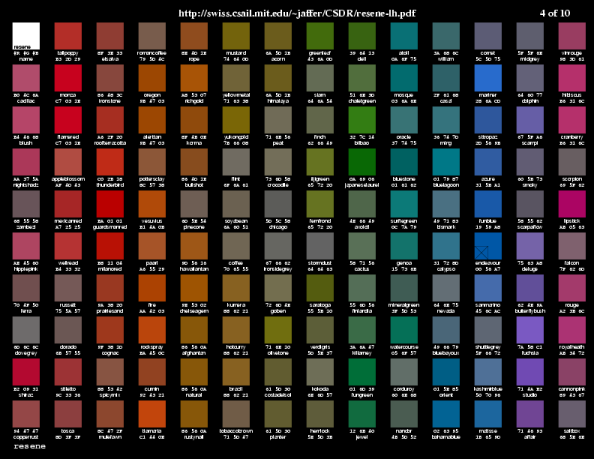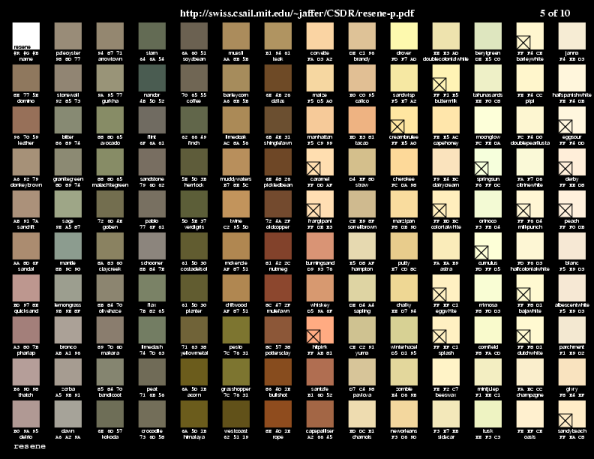

| http://people.csail.mit.edu/jaffer/Color/CSDR |
Color-Space Dimension Reduction |
The large color dictionaries available on-line do not come with charts or sample cards. This article describes a method developed for creating usable color catalogs. The 10-page charts in this article are of the Resene paint colors. Clicking on a catalog page image will fetch the 10-page PDF chart. Ignore the top left white patch on each page; it is a legend.

|
Trying to manually arrange hundreds or thousands of patches by color onto fixed size sheets seems a recipe for madness. Successfully mapping colors from a 3-dimensional color space to 2-dimensional sheets of paper while keeping similar colors close essentially reduces the dimension of that color space.
The straightforward method of 3-into-2 reduction is to slice the space in parallel layers, each holding the same number of colors.
After the colors are partitioned into pages, the colors are sorted by a second criterion and laid out in a serpentine pattern on the sheet; going down the first column, then up the second column, then down the third column, etc.
These sheets are sliced by the luminance (L of L*C*h), then sorted by hue (h of L*C*h):

|

|

|
If one is looking for pink, one must search both sides of several sheets to match a particular shade.
Is partitioning by hue any better?

|

|

|
The color patches don't transition smoothly across the page, and the rightmost rows are hard to distinguish from each other.

| Hilbert Space-Filling Curves |
|---|
A space-filling function is a parameterized function which maps a unit line segment to a curve in the unit square, cube, etc, which gets arbitrarily close to a given point in the unit cube as the parameter increases.
We want our space-filling function to preserve locality (if points are close on the line, then they are close in the cube) as much as possible. In studies such as [Bongki 2001] the Hilbert curve employed here performs well.
The inverse of the space-filling function is also well defined, taking coordinates in the unit cube and returning a number between 0 and 1. Let us order the color points by their positions on the unit line segment (as computed by the inverse space-filling function). Notice that we have reduced dimension not by 1, but by 2. The serpentine pattern described above arranges the color patches back into 2 dimensions on each sheet.

|

|

|
Notice the smoothness of color transitions on the serpentine path. Near matches to a color are usually found on only one or two pages of the catalog.
This Hilbert ordering is used for the generation of all the Color-Name Dictionary catalogs.

| Peano Space-Filling Curves |
|---|

|

|

|
|
I am a guest and not a member of the MIT Computer Science and Artificial Intelligence Laboratory.
My actions and comments do not reflect in any way on MIT. | ||
| Color | ||
| agj @ alum.mit.edu | Go Figure! | |